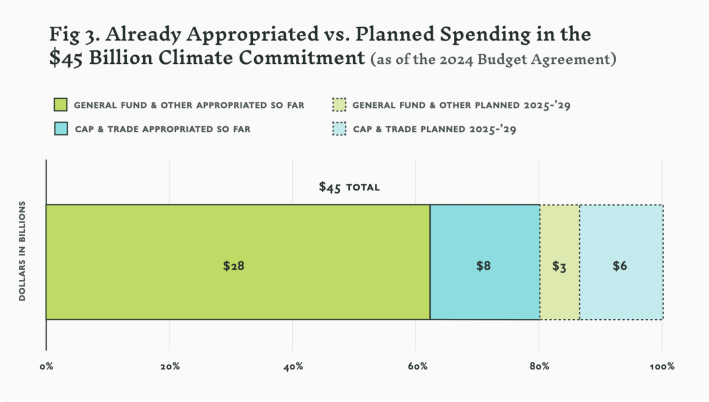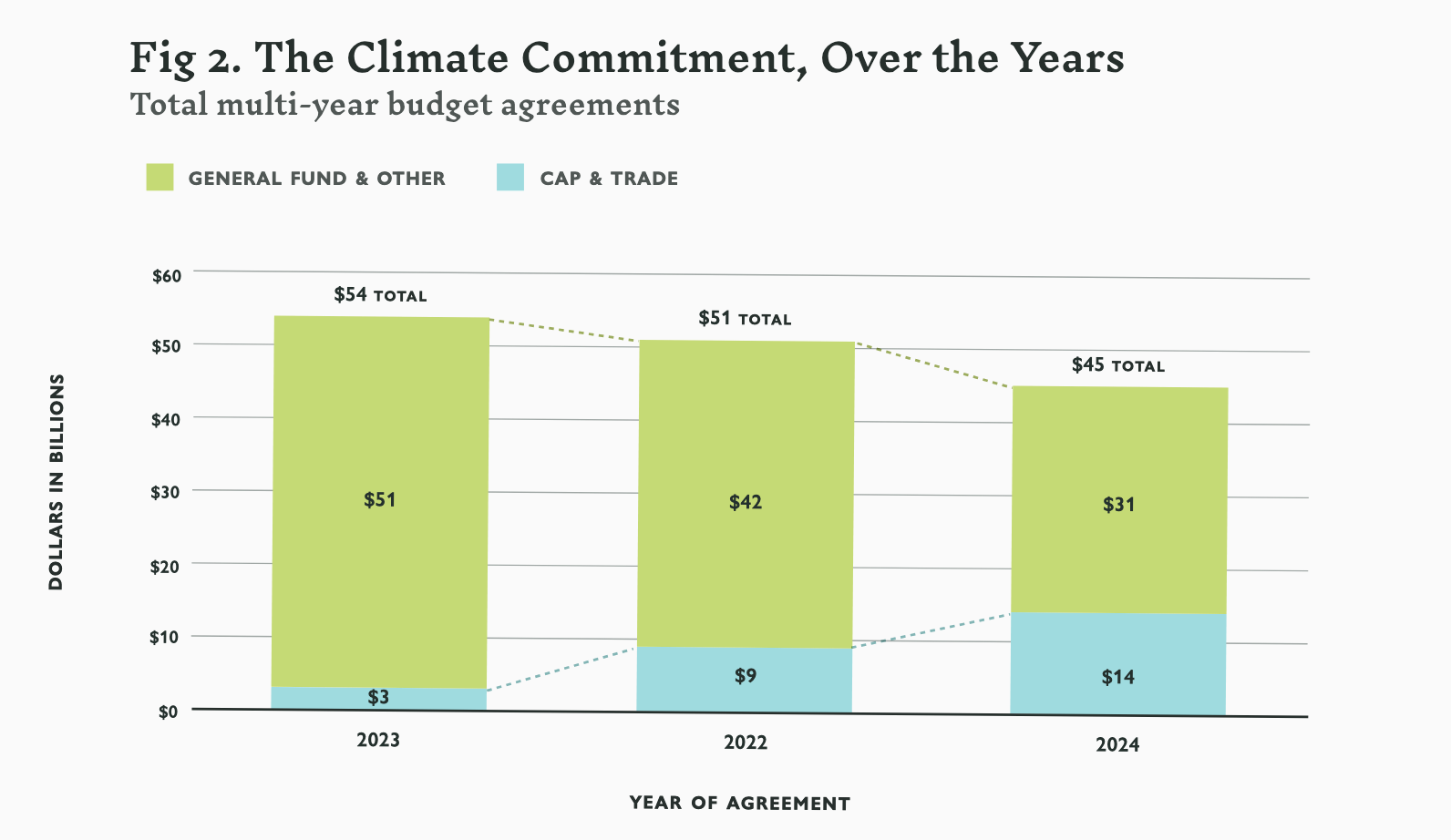Note: This post has been edited to correct some wrong numbers in the original version.
What began as a five-year, $54 billion plan to invest in climate action in 2022 has shrunk to a $45 billion plan over a stretched-out timeline. A new report calls the $36 billion that has been appropriated so far a commendably massive new investment in the climate fight, but warns that, given the way state revenues are going, completing what Governor Newsom has touted as the California Climate Commitment is looking very uncertain. In addition, almost a third of the $45 billion that remains of the original plan will come from the state's cap-and-trade program. That money, from the Greenhouse Gas Reduction Fund, was already going to climate programs, so claiming this as a new commitment on the part of the state is a bit wide of the mark.
What is needed, says the report, is for every California agency to do its budgeting with climate change in mind. The state also needs to commit to finding long-term, sustainable funding for climate action.
California Climate Commitment 2.0? Looking Toward a Fair and Sustainable Climate Budgeting Policy is from NextGen Policy, a group that advocates for policy change that addresses environmental, social, racial, and economic inequities in California "through justice-centered legislative advocacy, grassroots partnerships, and democratic civic engagement."
"With the enactment of the 2024 budget, California has reached the conclusion of its first iteration of the Climate Commitment, a historic initiative that dramatically augmented state climate spending by tens of billions of dollars over the course of several years," says the report. But now, "California stands poised to return to last decade’s business-as-usual approach to climate investments, which pits necessary investments against each other within the small pot of funding provided by cap and trade. This zero-sum approach is not sustainable in the face of an accelerating climate crisis - and taxpayers should not have to pick up the bill that climate polluters have given us to deal with."
NextGen launched the Climate 100 Project, of which this report is one product, to advocate for adopting an "all-of-government" approach to climate action budgeting. All agency budgets, according to the report, "should reflect the reality that climate action is not a luxury, but a necessity." And while California's "Climate Commitment" brought a welcome infusion of additional funding beyond cap-and-trade for decarbonization and climate resilience, it was temporary. The budget cycles that followed whittled the money down, and started taking it from the cap-and-trade program, "crowding out" existing climate efforts.
Meanwhile, other parts of the state budget continue to finance fossil fuel-dependent infrastructure such as freeways, undercutting the climate investments that are being made.
NextGen says the shift to using cap-and-trade funding "should be understood as a reduction in the overall level of climate investment from the original commitment. Cap-and-trade spending is a baseline for climate investment."
The 2024 budget agreement, which involved a painful process of elimination, cut about 27 percent of the original "commitment," and delayed some of what remains. Revenue forecasts beyond 2025 look grim, and funds have not already been appropriated face the possibility of being cut in future budget cycles.
Note what happened to the Active Transportation Program, which had a budget commitment of $1 billion in 2022, but saw most of that money taken away or delayed to future cycles, even though it had already been allocated. So much for commitment.
Tens of billions of dollars have already been spent or allocated to help decarbonize industry, put more clean energy sources onto the grid, build resilient communities, deploy nature-based solutions, and leverage billions more in federal matching funds. But the increasing reliance on cap-and-trade counts for about 2/3 of the remaining commitment - about $5 billion over several years, for a total of about $14 billion.

Using cap-and-trade money makes some sense for climate spending. For one, it insulates the funds from volatile general fund revenues, and would face less competition from other state budget priorities. Also, it has to be spent on reducing emissions, so it's an appropriate use of the money. It is also somewhat stable.
But, writes NextGen, it is limited. Relying on it to fund new programs means competing with previous commitments for a shrinking pie.
How to fix this?
The NextGen team offers several solutions.
First, grow the climate budget beyond cap-and-trade, including via the $10 billion climate bond on the upcoming ballot. Repayment of the bond should come from the general fund, not cap-and-trade, to ensure it is not just replacing that revenue. A $10 billion bond would not be enough to restore all the programs in the Climate Commitment, but it could be accomplished immediately and with the direct participation of voters.
Second, do a better job of making polluters pay. This means strengthening rules in the cap-and-trade program and the state's low carbon fuel standard, and ending tax breaks for fossil fuel companies.
It also means creating some kind of climate superfund, paid for by polluting industries, to hold those industries financially liable for the considerable damage their actions are costing the state's taxpayers.
Third, adopt climate budgeting across all state agencies, instead of considering it a stand-alone investment. For example, Caltrans spends billions of dollars on projects, like widening highways, that hinder climate efforts by encouraging further fossil fuel dependency. Every dollar invested in transportation going forward should support a sustainable, resilient climate, says NextGen, not the burning of fossil fuels. The state transportation budgeting process needs to reflect that.
"The climate impact of Caltrans’s failure to get traffic under control is huge," says the report. "Passenger vehicle tailpipes are the largest single source of climate pollution in the state, accounting for more emissions than the entire buildings and electricity sector combined. The state’s Scoping Plan for how to achieve our legislatively-required pollution reduction targets has identified transportation mode shift as a key strategy for decarbonization of the sector. [It] calls for California to reduce driving by thirty percent below 2019 levels in 2045. But highway spending continues to be a key driver of worsening traffic and pollution: unless Caltrans changes course, we will fail to reach these targets, in violation of multiple state laws."
Governor Newsom issued an executive order yesterday that focuses on housing that is an example of what's needed. It directs all state agencies, including Housing and Community Development but also Caltrans and the Air Resources Board, for example, to coordinate on finding ways to meet housing and climate goals at the same time.
Read the full report here.






